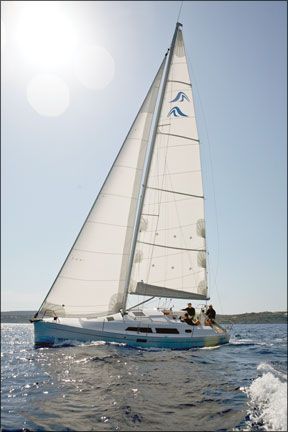I am a Florida coastal cruiser looking to replace the roller-furled 135-percent genoa on my Tartan 3500. One sailmaker says cross-cut is the only way to go; another says miter-cut is clearly superior, and will hold its shape better. The price quotes Ive gotten are essentially identical. I would appreciate your advice.
Robb Prince,
Polaris, 1993 Tartan 3500
Punta Gorda, Fla.

Photo courtesy of Hanse
Sailmakers put spin into more than their spinnakers, and when all is said and done, their art lies in turning flat material into a carefully controlled curved shape.
The best-shaped sails-and the most expensive to build-are tri-radial shapes that are made from many smaller panels radiating from each corner of the sail. These sails have many more seams and require more sewing but allow the bias, or strength axis, of the cloth to be critically aligned. Most racers and performance-oriented cruisers opt for the cut because the sail shape can be better developed with this approach.
A cross-cut and a miter-cut are both valid but simpler approaches to sailmaking. They lessen the number of panels and consequently the labor involved with manufacture. As long as the material used affords appropriate load handling characteristics associated with panel alignment, all is fine, especially for a cruising application where lighter weight and the final nuance of shape are less critical.
More important than whether the sail is cross cut or miter cut is how well it fits and sets on your boat, and the sailmaker to choose is the one who will come aboard and make sure that his or her handiwork actually fits properly. If they both agree to do that, then take a close look at the detail work in their sails. Is the area around pressed-in rings well-reinforced? Are leech lines easy to operate? How is UV protection handled?
Sewing Setup
I plan on sewing some boat cushions. Can you recommend a used sewing machine that can do canvas, etc.?
Ludek Sotelo,
Blue Marble, 1986 Express 37
Nanaimo, B.C.
The canvas makers sewing machine is an industrial-duty unit with fewer bells and whistles than whats found at Sears and Target. Those looking for a new machine that comes with great tech support and a cult of do-it-yourself project encouragement should take a look at the Sailrite machines. These overseas-built machines are tough and agile, and come from a vendor with a good track record of servicing do-it-yourselfers.
Those on a tight budget should visit local sewing machine repair shops, which often have a heavy cast-iron industrial-duty Singer, Adler, or Pfaff machine awaiting a new owner. Units with a walking foot and long arm are especially good for the canvas-oriented sailor. Beware of the run hard-and-put away wet deal often found at local swap meets. Like all mechanical equipment, theres a point when the beast is worn out and the cost of a makeover can be prohibitive.





































